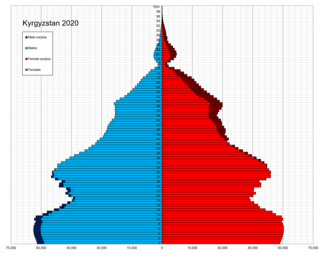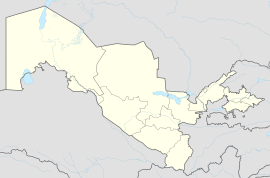
The Demographics of Kyrgyzstan is about the demographic features of the population of Kyrgyzstan, including population growth, population density, ethnicity, education level, health, economic status, religious affiliations, and other aspects of the population. The name Kyrgyz, both for the people and the country, means "forty tribes", a reference to the epic hero Manas who unified forty tribes against the Oirats, as symbolized by the 40-ray sun on the flag of Kyrgyzstan.

Demographic features of the population of Uzbekistan include population growth, population density, ethnicity, education level, health, economic status, religious affiliations, and other aspects of the population. The nationality of a person from Uzbekistan is Uzbekistani, while the ethnic Uzbek majority call themselves Uzbeks. Much of the data is estimated because the last census was carried out in Soviet times in 1989.

The Kirghiz Soviet Socialist Republic, also known as the Kyrgyz Soviet Socialist Republic, KySSR or Kirgiz Soviet Socialist Republic, was one of the constituent republics of the Soviet Union (USSR) from 1936 to 1991. It was also known by the names Kyrgyzstan and Soviet Kyrgyzstan in the Kyrgyz language, and as Kirghizia and Soviet Kirghizia in the Russian language. Landlocked and mountainous, it bordered Tajikistan and China to the south, Uzbekistan to the west and Kazakhstan to the north. The Kirghiz branch of the Communist Party of the Soviet Union governed the republic from 1936 until 1990.
Yangirabod or Yangirabot is a city and seat of Xatirchi District in Navoiy Region in Uzbekistan. The town population in 1989 was 11,364 people, and 17,000 in 2016.
Qamashi is a city in Qamashi District of Qashqadaryo Region in Uzbekistan. It is the capital of Qamashi District. The length of transport road from Kamashi to Karshi is 63 km. According to local information, the name Q is derived from the name of the kamaychi branch of the Uzbek Kungirot clan.The population of this city is 34 thousand people (2005). In Qamashi there is a cotton gin, a building materials factory, and other construction organizations, MTP, Qamashi car dealership company, computer clubs, a dog park, amusement parks, high-rise residences, a chain of hardware and food stores, "Langar Ota" shrine, "Mikron" company, a leather processing enterprise, and a wool factory. In addition, small, medium and large enterprises, micro-firms have been working for many years. There are 2 lyceums, 32 vocational colleges, 5 general education schools, children's music and sports schools, a central library, club institutions, and a cultural center this city. The district central hospital, polyclinic, maternity hospital, pharmacies and medical institutions serve the population. There are buses and route taxis from Qamashi to the regional center
Juma, meaning Friday in Uzbek is a city in Samarqand Region, Uzbekistan. It is the capital of Pastdargʻom District. The population of the town was 15,571 people in 1989, and 21,500 in 2016.
Qarluq is an urban-type settlement in Surxondaryo Region, Uzbekistan. It is the administrative center of Oltinsoy District. Its population was 3,842 people in 1989, and 3,900 in 2016.
Gʻallaorol is a city in Jizzakh Region, Uzbekistan. It is the administrative center of Gʻallaorol District. The town population was 16,623 people in 1989, and 24,700 in 2016. Situated on the Tashkent–Samarkand railway, it became a city in 1973.
Doʻstobod, until 1991 Soldatskiy is a city in Tashkent Region, Uzbekistan. It is the capital of Quyichirchiq District. Its population was 13,600 in 2000, and 16,200 in 2016.
Gulbahor is an urban-type settlement in Tashkent Region, Uzbekistan. It is part of Yangiyoʻl District. The town population in 1989 was 9,814 people.
Haqqulobod is a city in Namangan Region, Uzbekistan. It is the administrative center of Norin District. Its population is 27,000 (2016).
Bagʻdod is an urban-type settlement in Fergana Region, Uzbekistan. It is the administrative center of Bagʻdod District. The town population in 1989 was 10,086.
Dangʻara is an urban-type settlement in Fergana Region, Uzbekistan. It is the administrative center of Dangʻara District. Its population was 7,983 people in 1989, and 11,500 in 2016.
Yaypan is a city in Fergana Region, Uzbekistan. It is the administrative center of Uzbekistan District. The town population was 15,984 people in 1989, and 24,900 in 2016.
Poytugʻ or Paytug is a city in Andijan Region, Uzbekistan. It is the administrative center of Izboskan District. Its population was 19,389 in 1989, 29,200 in 2003, and 26,000 in 2016.
Paxtaobod is a city in Andijan Region, Uzbekistan. It is the administrative center of Paxtaobod District. Its population was 18,991 in 1989, 23,200 in 2003, and 34,400 in 2016.
The history of the Jews in Central Asia dates back centuries, where Jews have lived in countries which include Kyrgyzstan, Kazakhstan, Tajikistan, Turkmenistan, and Uzbekistan.
Tallimarjon is a town in Qashqadaryo Region, Uzbekistan. It is part of Nishon District. The town population was 6715 people in 1989, and 10,800 in 2016.
Boʻzsuv is an urban-type settlement in Tashkent Region, Uzbekistan. It is part of Yangiyoʻl District. The town population in 1989 was 3673 people.
Andijon is an urban-type settlement of Buloqboshi District in Andijan Region, Uzbekistan. The town population in 1989 was 4,549 people, and 12,200 in 2016.




